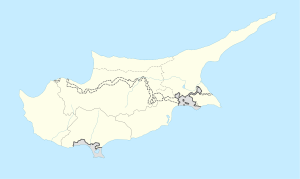Kaimakli
|
Kaimakli |
|
|---|---|
| Location in Cyprus | |
| Coordinates: 35°11′21″N 33°23′1″E / 35.18917°N 33.38361°ECoordinates: 35°11′21″N 33°23′1″E / 35.18917°N 33.38361°E | |
| Country |
|
| • District | Nicosia District |
| • Municipality | Nicosia |
| Population (2011) | |
| • Total | 11,564 |
| Time zone | EET (UTC+2) |
| • Summer (DST) | EEST (UTC+3) |
Kaimakli (Greek: Καϊμακλί [kaimaˈkli]; Turkish: Kaymaklı or Büyük Kaymaklı [ˈbyjyc kajmakˈɫɯ]) is a large northeastern suburb of Nicosia, Cyprus. Since 1968, it belongs to the Municipality of Nicosia. Its population in 2011 was 11,564.
It seems that Kaimakli derives from kaymak meaning [the] froth [in a cup of local coffee]. However Rubert Gunnis states that the suburb took its name from a farm which produced clotted cream which in Turkish is known as Kaymak.
Kaimakli has two churches, Saint Barbara's and Archangel Michael's, which was also a cemetery. In St. Barbara there are some interesting old icons, e.g. one of Virgin Mary dated back to 1763.
In the 19th and 20th Century the inhabitants of Kaimakli where famed for their building and labouring skills. In 1878 when the British arrived, they found that the Venetians had diverted the river Pediaios north of the city, but the old riverbed still ran through the centre, creating an open sewer and rubbish dump, which sometimes flooded into the surrounding streets. In 1881 the riverbed was covered, the municipality offered ownership of the area covered to labourers prepared to undertake the work. Much of it was done by builders from Kaimakli who thus built Hermes Street. Many of the shops built were then given to builders as a reward for their labour.
The Cyprus Government Railway (Section 1) was constructed in 1905 and the line passed through Kaimakli towards Nicosia . A Station Halt and siding was then built in 1909 at the corner of what is now Synergasias Street. This formed part of the old line and the rail tracks are now buried within the tarmac and St Hilarion. The Line and station closed on 31 December 1951. The Station was restored in 1995 and a Linear Park was constructed on over a kilometre of the old track.
...
Wikipedia

